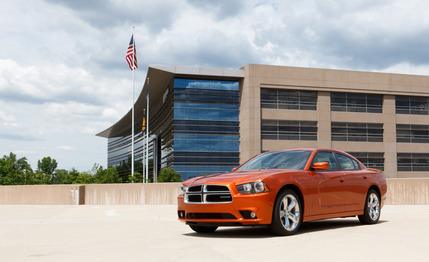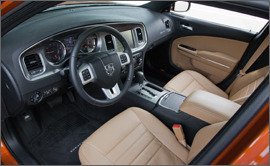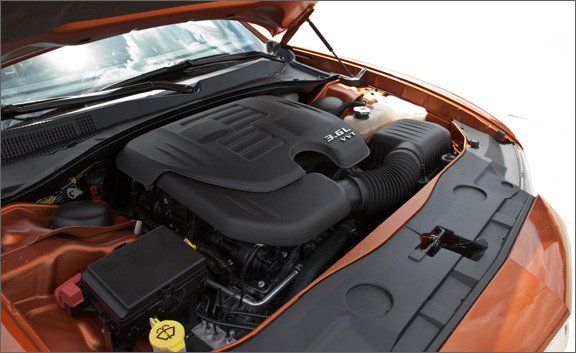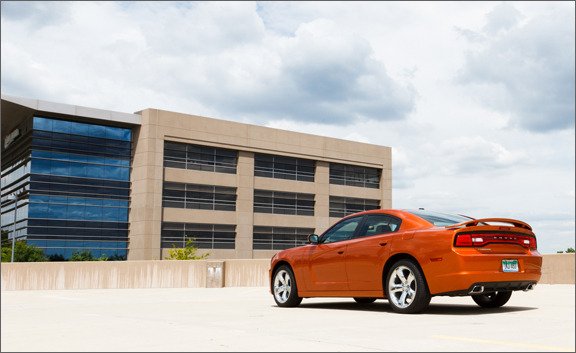 Short Take Road Test
Short Take Road Test
When Fiat swept to Chrysler’s rescue, many people—including us—were simultaneously relieved and concerned. We were happy that a major automaker would live on but worried that the savior ended up being an Italian automaker well known for many of the same issues (poor perceived quality, cost-cutting engineering) that got the pentastar company in trouble in the first place. Regardless of those reservations, there’s no denying the succulent first fruits of the tie-up. For the 2011 model year, nearly every model in the Chrysler, Dodge, and Jeep families received a remarkably effective interior renovation. The Dodge Charger and its Chrysler 300 sibling benefited from a more robust rework, including thorough chassis and powertrain updates and new exterior styling.
Regarding the 2011 Charger, the interior is particularly pleasing in examples with the no-cost-option black-and-tan interior fitted to our test car. Opt for this combination on higher trims levels, and not only are the seats wrapped in soft, caramel-colored leather, but the door panels also get a two-tone treatment that looks particularly rich. The Charger’s carpet and floor mats remain black no matter what the interior color, however, largely defusing one of the most common complaints about lighter cabins, namely, the difficulty of keeping them clean.
Elsewhere, the new soft-touch, one-piece dash molding keeps the look clean and uncluttered—although it sounds as hollow as a kettle drum when rapped with a knuckle. The instrument panel and the center stack are trimmed in a sort of perforated houndstooth-textured aluminum, a finish that’s far more graceful in person than in description. From the driver’s perspective, the Italians have had an undeniably beneficial influence on the latest Charger.

American Car, Italian Overlords, German Feel
In addition to the fantastic reupholstering job, engineers fussed with the suspension. This was as successful as the interior redesign: This beefy, 4113-pound American sedan has a decidedly Bavarian balance of ride comfort and handling, and its predecessor never felt so sophisticated. Body control is admirable, the Charger allowing just a few degrees of tilt during aggressive cornering, and neither end overwhelms the other as the 0.82-g limit approaches. Much of the credit for this balance goes to the V-6–powered car’s 51.5/48.5 front-to-rear weight distribution. This Charger was 232 pounds lighter than the V-8 R/T we tested earlier this summer, with 190 of those removed from over the front axle.
The Charger’s steering was a similarly welcome surprise. Pleasingly weighted, it responds immediately off-center without being twitchy. There’s not much feedback at the helm, however, but thanks to the 20-inch wheels on our test car, we noted plenty of kickback from midcorner bumps. Those 20s also contribute to our one complaint about the Charger’s ride—severe impact harshness—and certainly don’t help combat the alarming brake fade we noted. Our 70-to-0-mph braking distance increased by 20 feet from one stop to the next, with the pedal beginning to soften after one hard stop. The R/T we tested also had 20-inch wheels and had no trouble stopping, thanks to its upgraded brakes. Yes, this is a big sedan, and large-diameter wheels look nice on it, but trust us when we say you probably want smaller ones.
Eight Would Be Great
The Pentastar V-6 was welcomed with relief when it debuted for the 2011 model year, but even if it is interplanetary leaps and bounds better than the engine it replaced, it is far from the complete powertrain solution Dodge and Chrysler need. The 292-hp 3.6-liter needs to climb high into the tach to get much done, but the five-speed automatic behind it is geared for maximum efficiency and the revs come slowly. The car holds first gear until almost 60 mph, with second stretching nearly to 100. Aggravating as this approach is in around-town driving, it did result in observed fuel economy of 20 mpg.

At the track, reacting to the 2.8 seconds the Charger needed to accelerate from rest to 30 mph—that’s only 0.1 second quicker than the last Kia Rio we tested—our test driver noted “terrible launch!” on the car’s test sheet. The engine pulls noticeably harder above 4500 rpm, like a 1980s turbocharged engine arriving fashionably late. Unfortunately, it also feels noticeably coarser above 4500 and only gets more so toward redline. After 7.2 seconds—and much thrashing—the Charger is going 60 mph, with the quarter-mile passing in 15.7 seconds at 94 mph. We’ve said it before and would very much like not to say it again: The eight-speed automatic Chrysler will introduce soon for these cars cannot come soon enough.
Lots of Available Stuff, Lots of Potential Expense
That transmission is a lonely weak spot on the Charger, though. The car is priced competitively, and the menu of optional equipment is long. A base V-6 Charger starts at $26,220; for $4000 more, a Rallye Plus like the one tested here adds Chrysler’s UConnect phone and music integration with an 8.4-inch touchscreen, USB and auxiliary ports, Bluetooth, satellite radio, and a 276-watt amplifier and six speakers. It also has remote start, air conditioning, leather seats (heated all around), a leather-wrapped steering wheel and shift knob, 18-inch wheels—up from the base car’s 17s—and heated and cooled cup holders for the front row. None of this stuff would matter in a rally, which is perhaps why the package is called Rallye—an extraneous “e” also does not matter in rallies.
The car tested here is doubly Rallye, with the $1195 Rallye Appearance package upping the wheel diameter to 20 inches, the amplifier power to 506 watts, and the speaker count to nine. A body-color spoiler joins the wheels in covering the “Appearance” part of the package name, and this bundle firms up the suspension. Our example then added every additional option but the $50 engine-block heater. First up was the $1495 Driver Confidence Group, which nets blind-spot and cross-path detection, parking assist, a backup camera, rain-sensing wipers, and auto-dimming mirrors—but no quiet yet firm affirmations of self. Then came the Driver Convenience Group, which costs $575 and consists of power-adjustable pedals and steering column. An adaptive cruise-control system somewhat strangely bundled with a heated steering wheel goes for $925. Garmin navigation software ran $450, and a sunroof $950. Our car even wore $295 extra-cost paint: Toxic Orange Pearl. (So, yeah, we had an orange Charger. As the author writes this, he realizes he’s wearing an old Dukes of Hazzard T-shirt and “yeehaws” softly to himself.) For this car’s as-tested price of $36,105, though, we’d have to silence our powertrain complaints and crank up the hillbilly hijinks with a 370-hp Hemi R/T; it starts at just over $31,000.
The Charger is an interesting summary of the new Chrysler/Dodge under Fiat’s ownership. Much about the car feels very right, with aspects of it—the solid structure, the ride-and-handling balance—approaching excellence. But there is work to do. Dodge has taken one giant leap with this latest Charger, but a small step (or three of them—namely, sixth, seventh, and eighth gears) remains.
